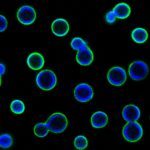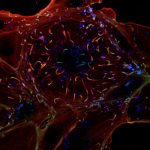Not a virus, but a fungal particle!
(Read the full article : “Cryptococcus extracellular vesicles properties and their use as vaccine platforms”, Juliana Rizzo et al. JEV, 2021)
Extracellular vesicles (EVs) are small membranous particles released by cells in all domains of life. These tiny lipid bags become big players by delivering messages during intercellular communication. Our recent publication unravelled the secrets and hallmarks of EVs obtained from a major fungal pathogen: Cryptococcus. We observed that Cryptococcus-derived EVs bear a complex fibrillar structure, previously unappreciated in fungi. This novel vesicular feature, resembling the encapsulated virus structures, comprises immunogenic mannoproteins that might regulate diverse host-pathogen interactions. EV-immunized mice showed a strong antibody response and had a prolonged survival upon Cryptococcus infection. Our results pointed out to the use of fungal EVs as promising vaccine platforms against fungal infections.
Extracellular vesicles (EVs) from the human pathogen Cryptococcus neoformans explored by cryo-electron microscopy and cryo-electron tomography. Tomograms (left panel) were used to reconstruct EV 3D models (right panels), revealing a complex fibrillar structure (yellow) covering the vesicular lipid bilayers (purple).
Read the full article : “Cryptococcus extracellular vesicles properties and their use as vaccine platforms”, Juliana Rizzo et al. JEV, 2021
















